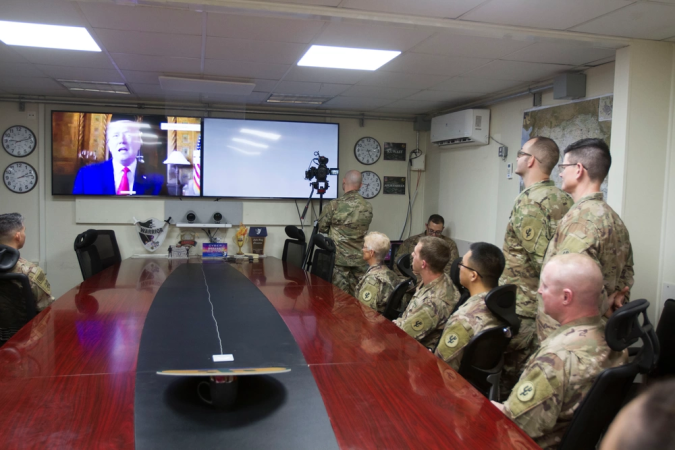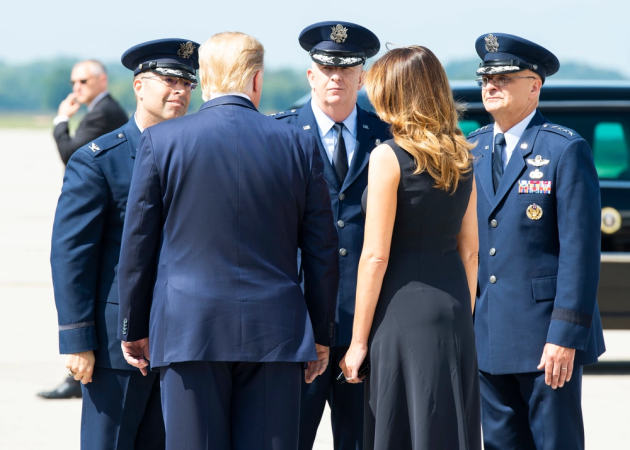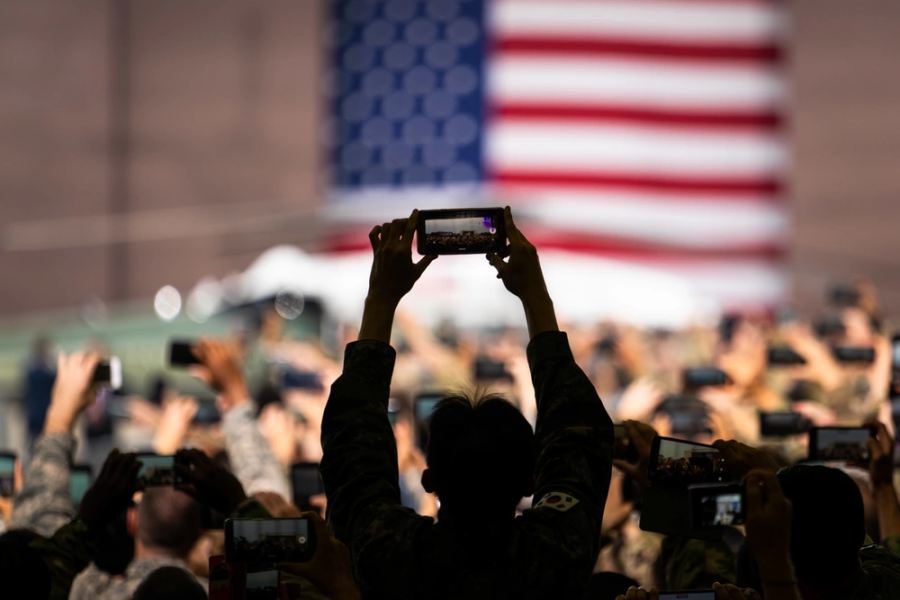When Donald Trump begins his second term as president in January, national security law experts predict he may return to his old habit of issuing orders to the military via social media, a practice which could cause confusion in the ranks as the relevant chains of command seek clarity to carry out the commander in chief’s intent.
During his first term, Trump used Twitter, now known as X, to signal policy decisions, often from the hip: a 2018 warning to fire “nice and new and ‘smart’” missiles at Syria surprised his aides and disrupted plans with U.S. allies. In 2017, he tweeted his decision to ban transgender troops from the military and in 2020 he tweeted that all U.S. troops would be out of Afghanistan by the end of the year.
In 2019, Trump also used Twitter to intervene in the case of Chief Petty Officer Eddie Gallagher—a Navy SEAL who had been convicted of posing for a photograph with the corpse of an Islamic State prisoner—telling the Navy to let Gallagher keep his Trident pin, the symbol of being a SEAL.
Trump’s tweets count as official statements of the president, the Department of Justice said in 2017, but Defense officials did not always jump to carry them out. For example, in the Gallagher case, then-Navy Secretary Richard Spencer told Trump he needed the Trident intervention in writing for it to count as an official order.
Even so, tweets from the commander in chief meet all the criteria for a military order, they’re just not the best way of issuing orders, argued Butch Bracknell, a retired Marine judge advocate and national security expert.
“If the President of the United States issues an order by tweet, and it’s a lawful order, and it’s heard and understood by the person to whom it’s directed, that’s the end of it,” Bracknell told Air & Space Forces Magazine. “It is legal but it is a terrible practice. In my view it puts a burden on the person receiving the order to clarify.”
Bracknell made a similar argument during Trump’s first term in a 2020 opinion piece for Task & Purpose. Under the Uniform Code of Military Justice, an order from the President counts as an order if it regards a subject within his or her jurisdiction, is lawful, is authentic, and gives comprehensible direction, Bracknell pointed out. Typically, orders are carefully written and distributed to avoid confusion.
“We want a rifle squad leader or a destroyer squadron commander to be clear about what he’s been tasked with doing, and that’s why we have a process,” he said. “There’s a science and an art to orders-writing, and we do it in order to reduce ambiguity so that people know what latitude they have to act.”
Doing so typically requires coordination and negotiation with the relevant parties, explained Scott Anderson, a fellow in governance studies at the Brookings Institution and a former legal advisor at the State Department.
“Usually commands go through a process of clarification, discussion, expansion by different people in the chain of command to clarify what the role is for the people implementing it several layers down,” he said. “So if the president authorizes the military to intervene in Iraq, for example, there’s a big coordinated effort to implement that.”
Careful coordination is particularly important in delicate national security situations, said Tony Johnson, president and CEO of the Truman National Security Project, who once served as an intelligence advisor to the deputy secretary of defense.
“We want to ensure there’s no misinterpretation, no bad signaling to allies and adversaries,” he said.

Effects
But as thorough as the process may be, it is not legally required to transmit a lawful order.
“There’s no defined medium by which a commander in chief is required to give orders,” Anderson said. “There’s no requirement that they be in writing or of a particular type.”
What happens if the typical process is not followed? Social media posts usually lack the specificity for service members to execute without clarification, experts said, which means most troops will ask their chain of command for clarity before acting. The lack of specificity also means posts likely will not hold up in court if troops do not immediately act on them, Anderson said. But they can still cause confusion and make it more difficult for the president to achieve his goals.
“Does that mean there is not some risk of somebody down the chain of command doing something unexpected because they thought that’s what the president wanted? No, and that risk is exactly why this is a bad idea and the president shouldn’t do it,” he said. “The greater impact is simply stress, disarray, and confusion within the ranks, which ultimately makes it harder and less efficient for the people trying to do what the president wants to do.”
There would be even more confusion for orders that could be considered unlawful, such as striking cultural sites or using lethal force within the U.S.
Service members are not required to obey unlawful orders, but the bar for proving an order is unlawful can be very high, Anderson said. For example, a 2022 analysis by the Brennan Center for Justice, a law and policy research group, found that the Insurrection Act, which allows the president to deploy the military domestically in certain situations, “is dangerously overbroad and ripe for abuse.”
Last month, the chairman of the Senate Armed Services Committee, Sen. Jack Reed (D-R.I.) told reporters the Insurrection Act “could be improved significantly” and that the Posse Comitatus Act, which largely precludes federal military forces from acting as civilian law enforcement, is also in need of reform.
In 2020, Trump threatened via tweet to strike dozens of Iranian cultural sites, an act the Pentagon considered unlawful and refused to follow up on. Trump eventually dropped the matter, but if he were to insist on a similar case in the future, it would put the Defense Department in a difficult state.
“If the president persisted through the chain of command,” Anderson said, “then [service members] would hit the hard pressure: ‘are we confident this is unlawful enough that we don’t have to abide by it? And are we willing to risk our personal liberty on that, because we would be potentially charged in a court-martial.’ That’s a harder question.”

What to Do
It remains to be seen whether Trump will be as active on social media in his second term as president as he was in his first term. One complicating factor is Trump’s change of platforms. The president was banned from Twitter after the attack on the U.S. Capitol in January 2021, and while billionaire Elon Musk reinstated Trump’s account after buying Twitter in 2022, Trump said at the time that he preferred his new platform, Truth Social. Trump began tweeting again in August 2023, though by that point Musk had renamed the platform X.
In the days since his reelection, Trump has issued policy statements from X, which now allows paying subscribers to post up to 25,000 characters – far greater than the old limit of 280. Bracknell expects to see more orders-by-tweet or, more accurately, by X post, in the near future, because Trump has fewer constraints than he did in his first term.
“He doesn’t have to worry about electoral politics because he’s in his second term,” Bracknell said. “Second term presidents always have a lot more latitude because the political consequences are attenuated.”
But the risk of those posts sparking a conflict may be lower now because the U.S. has a smaller military footprint worldwide today than it did during Trump’s first term, Anderson said.
“Instead of targeting Iran or that kind of thing, it may be more about standards for [Diversity, Equity, and Inclusion] or other policies within DoD,” he said.
If service members do find themselves wondering whether they should act on a social media order from the president, the experts all offered similar advice: ask your chain of command.
“You have superior officers who are supposed to help you understand how to best do your job,” Anderson said. “If there’s any confusion, ambiguity, or anything seems unusual, check with your commanding officers to get clarification.”
Katherine Kuzminski, Deputy Director of Studies at the Center for a New American Security, offered that service members swear an oath to protect and defend the constitution, no matter who’s in office.
“That is part of the stability of what our professional all-volunteer force provides to the nation,” she said. “They don’t belong to a partisan community.”


